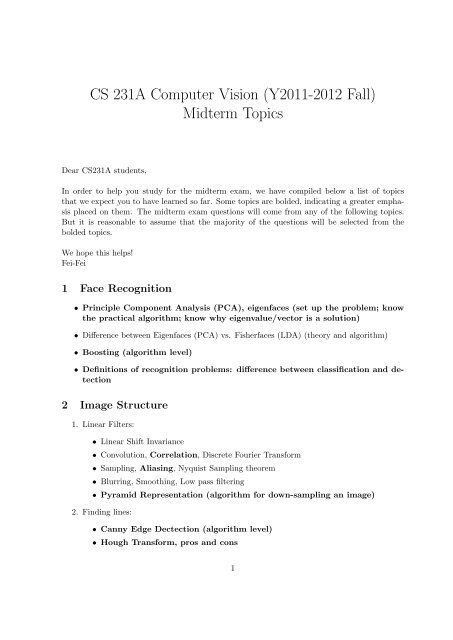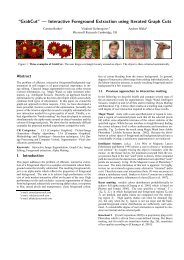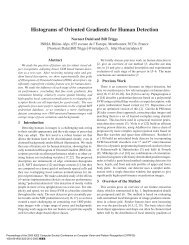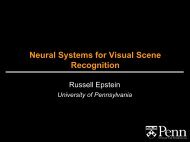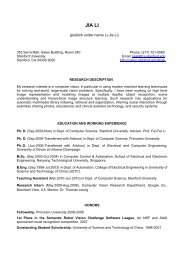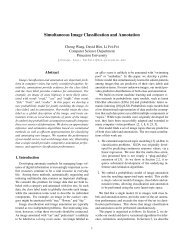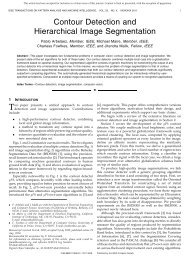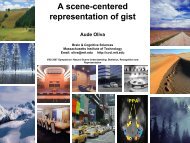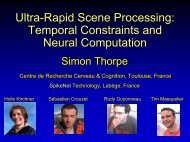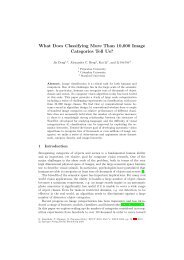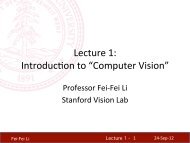Midterm Topics - Stanford Vision Lab
Midterm Topics - Stanford Vision Lab
Midterm Topics - Stanford Vision Lab
You also want an ePaper? Increase the reach of your titles
YUMPU automatically turns print PDFs into web optimized ePapers that Google loves.
CS 231A Computer <strong>Vision</strong> (Y2011-2012 Fall)<br />
<strong>Midterm</strong> <strong>Topics</strong><br />
Dear CS231A students,<br />
In order to help you study for the midterm exam, we have compiled below a list of topics<br />
that we expect you to have learned so far. Some topics are bolded, indicating a greater emphasis<br />
placed on them. The midterm exam questions will come from any of the following topics.<br />
But it is reasonable to assume that the majority of the questions will be selected from the<br />
bolded topics.<br />
We hope this helps!<br />
Fei-Fei<br />
1 Face Recognition<br />
∙ Principle Component Analysis (PCA), eigenfaces (set up the problem; know<br />
the practical algorithm; know why eigenvalue/vector is a solution)<br />
∙ Difference between Eigenfaces (PCA) vs. Fisherfaces (LDA) (theory and algorithm)<br />
∙ Boosting (algorithm level)<br />
∙ Definitions of recognition problems: difference between classification and detection<br />
2 Image Structure<br />
1. Linear Filters:<br />
∙ Linear Shift Invariance<br />
∙ Convolution, Correlation, Discrete Fourier Transform<br />
∙ Sampling, Aliasing, Nyquist Sampling theorem<br />
∙ Blurring, Smoothing, Low pass filtering<br />
∙ Pyramid Representation (algorithm for down-sampling an image)<br />
2. Finding lines:<br />
∙ Canny Edge Dectection (algorithm level)<br />
∙ Hough Transform, pros and cons<br />
1
∙ RANSAC, pros and cons<br />
3. Segmentation and Clustering:<br />
∙ Gestalt principles and cues<br />
∙ k-means clustering<br />
∙ mean-shift segmentation<br />
∙ Mixture of Guassians, Expectation Maximization (EM) algorithm<br />
– Be able to compare and contrast the above methods (theory and understand<br />
when each should be used)<br />
∙ Spectral clustering<br />
∙ Normalized cut (theory and practical approximation, how to set up the<br />
problem, and obtain eigensolutions)<br />
3 Camera models<br />
∙ Pinhole Camera Geometry<br />
∙ Homogeneous Coordinates<br />
∙ Different camera models: weak, affine, projective<br />
– How are parallel lines mapped<br />
∙ Vanishing points and lines<br />
∙ Intrinsic and extrinsic parameters (definitions, properties)<br />
∙ Affine camera model (properties)<br />
∙ Camera calibration<br />
∙ Epipolar geometry<br />
– Essential matrix<br />
– Fundamental matrix<br />
– 8-pt algorithm<br />
– Rectification: what is it why is it useful<br />
∙ Stereo vision<br />
– Correspondence<br />
– Reconstruction<br />
∙ Structure from motion<br />
– Factorization algorithm<br />
2
4 Technical tools<br />
∙ Least square, langrangian, system of linear equations (Ax=b)<br />
∙ Linear algebra<br />
∙ Classification: boosting<br />
∙ Unsupervised clustering<br />
– EM<br />
– Eigensolutions<br />
∙ Correlation, convolution<br />
∙ Image normalization<br />
3


